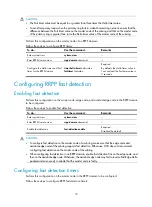
57
IP address configuration is prohibited on the control VLAN interfaces.
2.
Data VLAN
A data VLAN is a VLAN dedicated to transferring data packets. Both RRPP ports and non-RRPP ports can
be assigned to a data VLAN.
Node
Each device on an RRPP ring is a node. The role of a node is configurable. RRPP has the following node
roles:
•
Master node—Each ring has one and only one master node. The master node initiates the polling
mechanism and determines the operations to be performed after a change in topology.
•
Transit node—Transit nodes include all the nodes except the master node on the primary ring, and
all the nodes on subrings except the master nodes and the nodes where the primary ring intersects
with the subrings. A transit node monitors the state of its directly-connected RRPP links and notifies
the master node of any link state changes. Based on the link state changes, the master node
chooses the operations to be performed.
•
Edge node—A node residing on both the primary ring and a subring at the same time. An edge
node is a special transit node that serves as a transit node on the primary ring and an edge node
on the subring.
•
Assistant-edge node—A node residing on both the primary ring and a subring at the same time. An
assistant-edge node is a special transit node that serves as a transit node on the primary ring and
an assistant-edge node on the subring. This node works in conjunction with the edge node to detect
the integrity of the primary ring and perform loop guard.
As shown in
, Ring 1 is the primary ring and Ring 2 is a subring. Device A is the master node
of Ring 1, Device B, Device C and Device D are the transit nodes of Ring 1. Device E is the master node
of Ring 2, Device B is the edge node of Ring 2, and Device C is the assistant-edge node of Ring 2.
Primary port and secondary port
Each master node or transit node has two ports connected to an RRPP ring, one serving as the primary
port and the other serving as the secondary port. You can determine the role of a port.
1.
Primary port and secondary ports of a master node have the following functions:
•
The primary port sends loop-detect packets; the secondary port receives loop-detect packets.
•
When an RRPP ring is in Health state, the secondary port of the master node logically denies data
VLANs and permits only the packets of the control VLANs.
•
When an RRPP ring is in Disconnect state, the secondary port of the master node permits data
VLANs—forwards packets of data VLANs.
2.
There is no difference in function between the primary port and the secondary port of a transit
node. Both transfer protocol packets and data packets over an RRPP ring.
As shown in
, Device A is the master node of Ring 1. Its Port 1 is the primary port of the master
node on Ring 1, and its Port 2 is the secondary port of the master node on Ring 1. Device B, Device C,
and Device D are the transit nodes of Ring 1. Their Port 1s are primary ports of transit nodes on Ring 1,
and their Port 2s are secondary ports of transit nodes on Ring 1.
Common port and edge port
Common ports: Edge node ports and assistant-edge node ports that connect to the primary ring are
common ports.
Edge ports: Edge node ports and assistant-edge node port s that connect only to the subrings are edge
ports.
















































